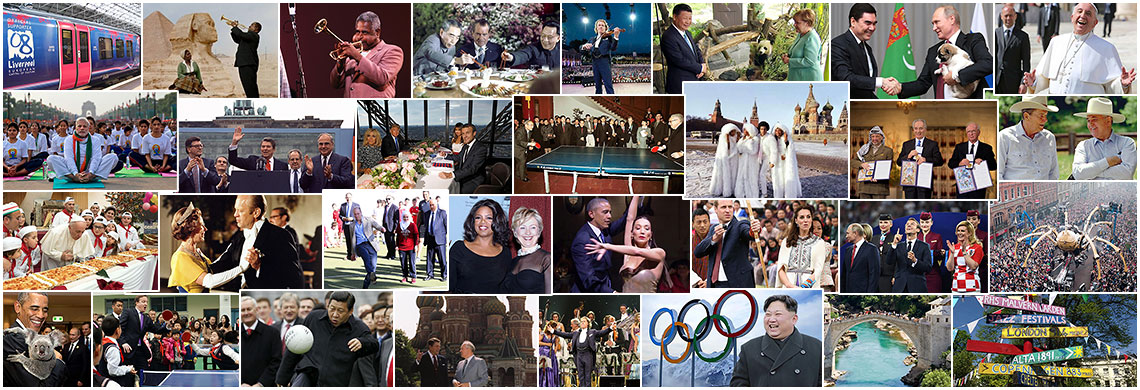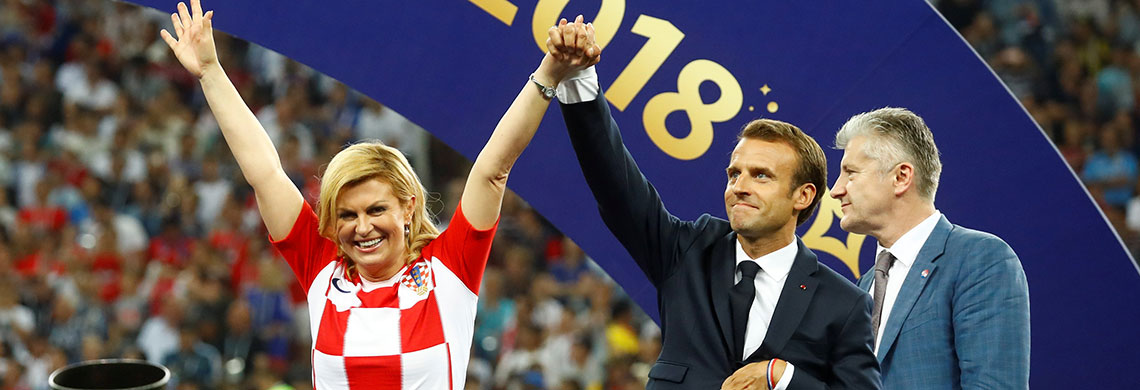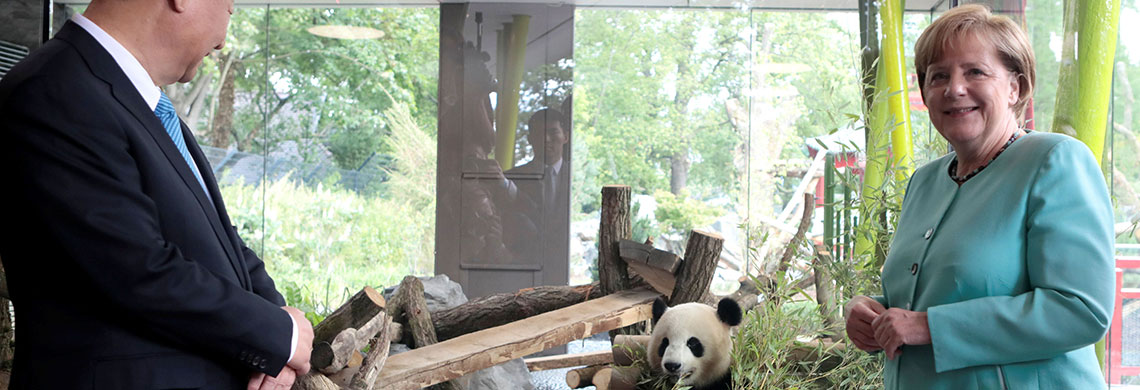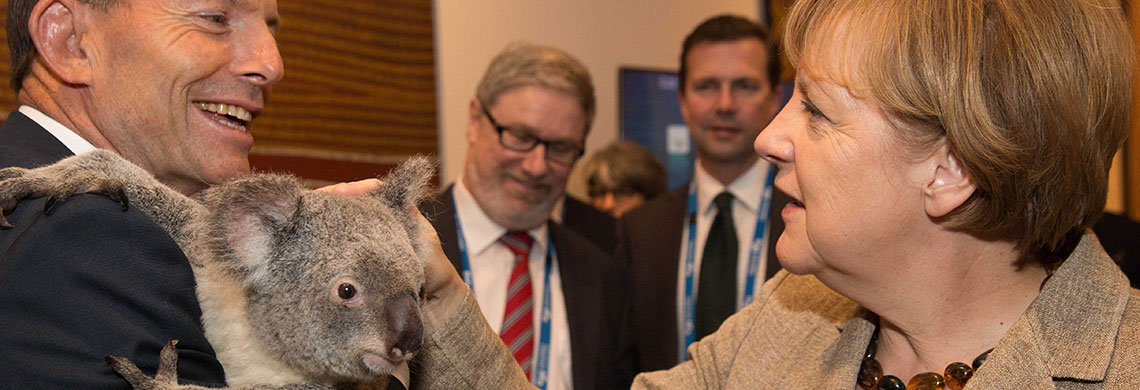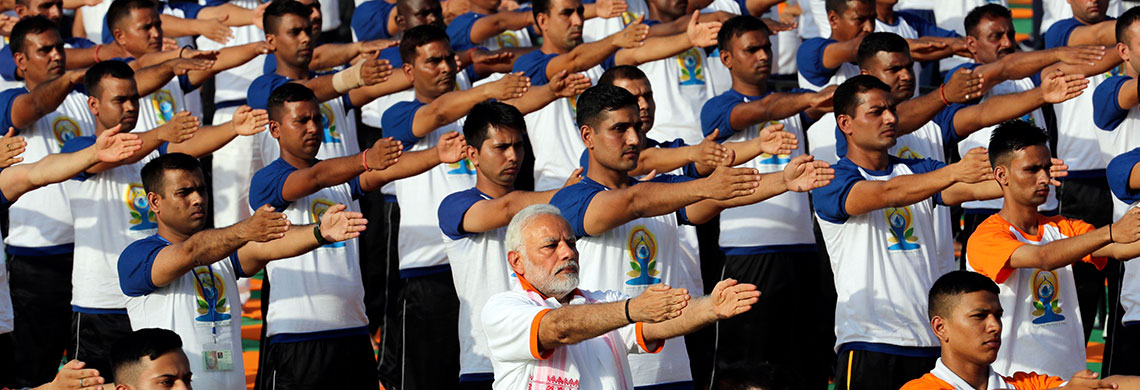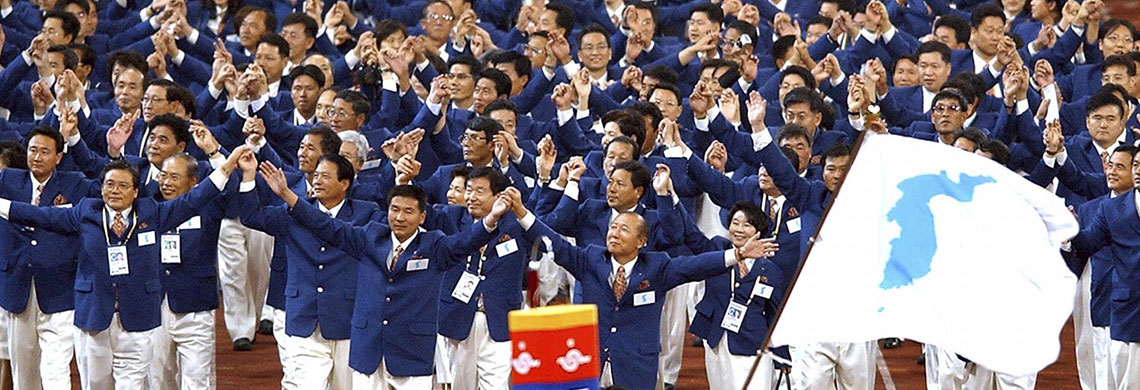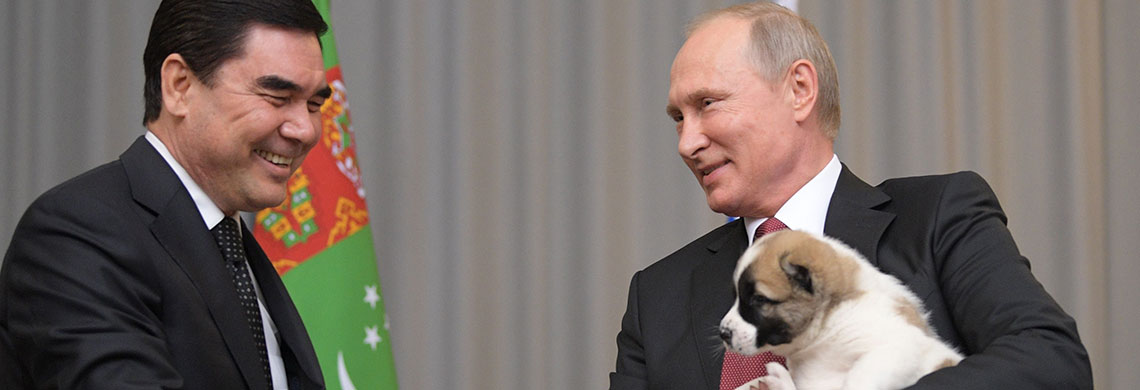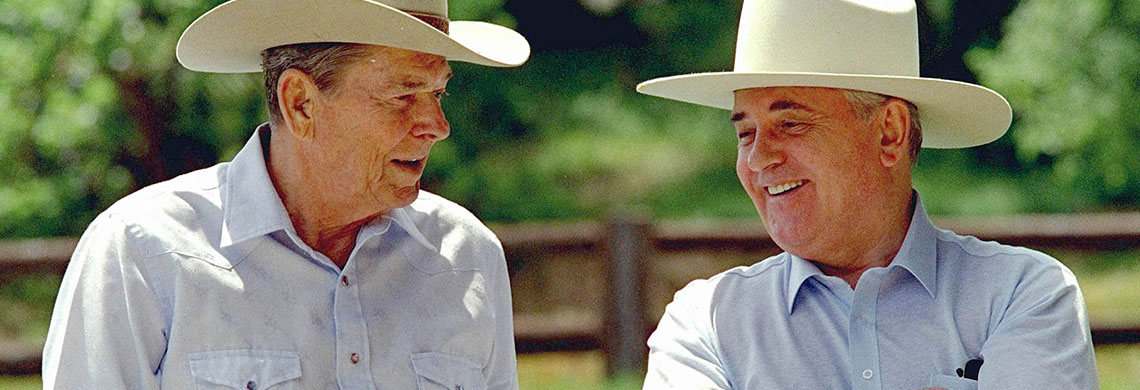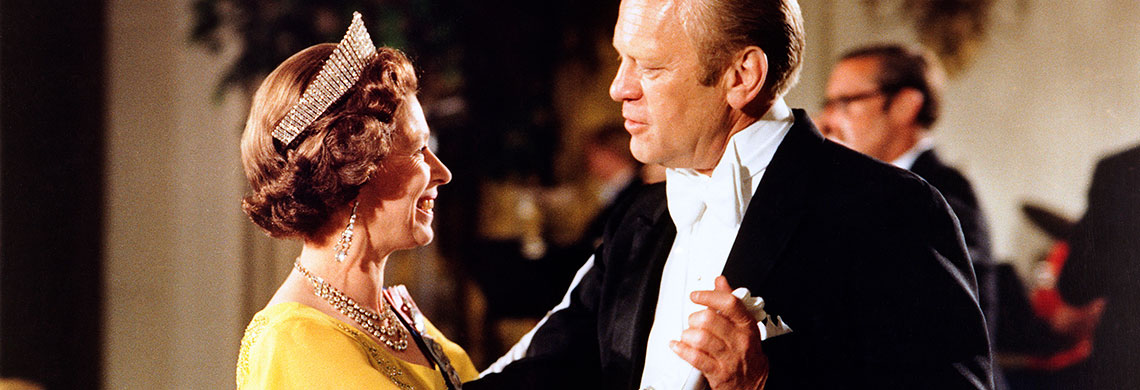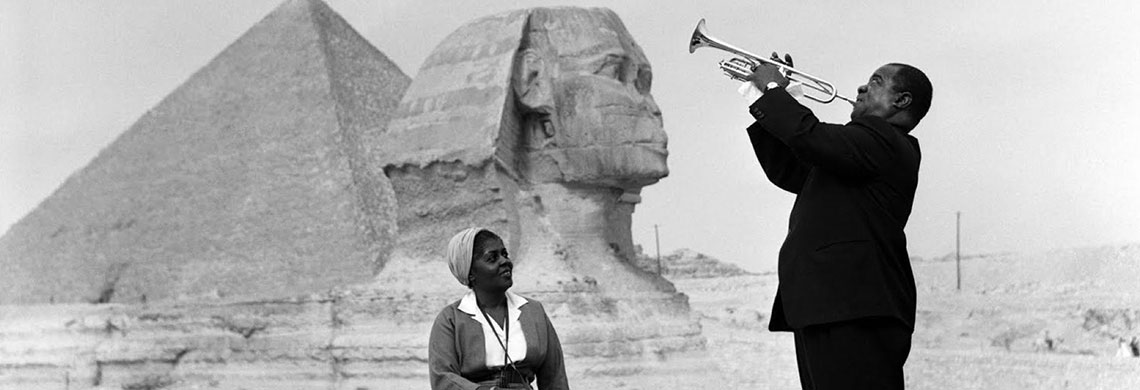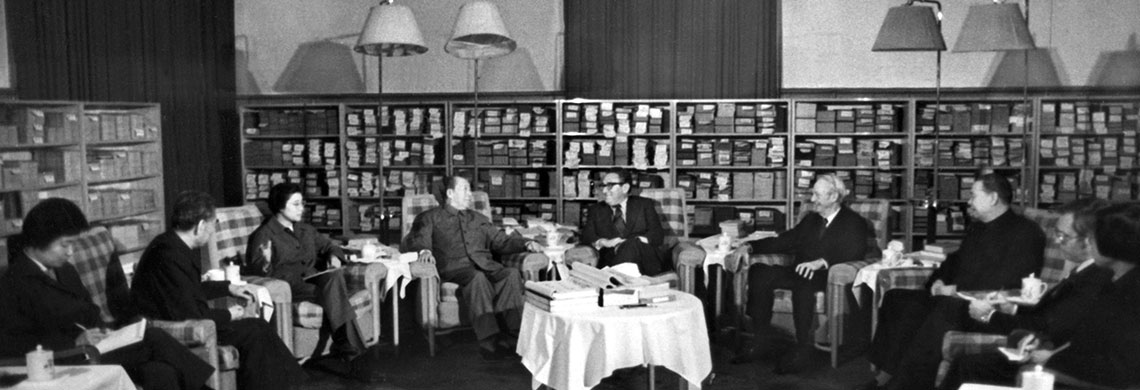Academy for Cultural Diplomacy
Cultural Diplomacy Research
Historical Acts of Cultural Diplomacy

Historical Acts of Cultural Diplomacy
In this section, readers can find a list of historical examples of successful acts of cultural diplomacy practiced by different actors since the end of the Second World War using different aspects of culture and other elements to represent and demonstrate what humanity shares in common through our cultures. These acts have served throughout the years as a catalyst to promote cooperation and to ease conflicts.Through the medium of art, music and sport, countless individuals and groups have employed cultural diplomacy throughout history; drawing attention to issues of universal concern through cultural expression to ease conflict and promote international cooperation. Through this timeline, the ICD recounts keystone acts of Cultural Diplomacy in action, demonstrating its exemplification in a manner surpassing pure theory, thus making the concept more accessible and engaging.
Ranging from events such as the launch of the Fulbright Program, to the recent Hijab Appeal, individual acts of cultural diplomacy in practice throughout history are documented, paying tribute to both major and less publicized instances of operationalized cultural diplomacy.
Below you will find a selection of examples of such successful cultural diplomacy acts that have had significant impacts or results:
-
1945 until 1991 (1994 - "Amerika")
COLD WAR CULTURAL DIPLOMACY
"Amerika", "USSR" and "Soviet Life" as tools for Cultural Diplomacy in Cold War
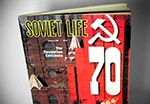 "Amerika" was a U.S. Information Agency (USIA) produced, Russian language magazine, it evaded strict Soviet censorship on printing and attemtped to provide their public with an unfiltered view of the West. It sought to provide the USSR with an unaltered view of the United States on the other side of the "Iron Curtain". Stalin's death led to a renewed Soviet-American cultural agreement in October 1956 and the development of a reciprocal distribution scheme of public media. At this time "The USSR/Soviet Life" was also being distributed in the US, "Soviet Life" remain apolitical and only showcased USSR culture (including minorities), science, education and general life. "Amerika" attempted to showcase the benefits of Capitalism but in a non-political sense. Both magazines acted as a window the other country and both were highly sought after in a world of "us versus them" mentalities. Overall, the magazines helped to promote public diplomacy between two superpowers and sought to inform, educate and enlighten their readers up until 1991, with the fall of the Soviet Union.
"Amerika" was a U.S. Information Agency (USIA) produced, Russian language magazine, it evaded strict Soviet censorship on printing and attemtped to provide their public with an unfiltered view of the West. It sought to provide the USSR with an unaltered view of the United States on the other side of the "Iron Curtain". Stalin's death led to a renewed Soviet-American cultural agreement in October 1956 and the development of a reciprocal distribution scheme of public media. At this time "The USSR/Soviet Life" was also being distributed in the US, "Soviet Life" remain apolitical and only showcased USSR culture (including minorities), science, education and general life. "Amerika" attempted to showcase the benefits of Capitalism but in a non-political sense. Both magazines acted as a window the other country and both were highly sought after in a world of "us versus them" mentalities. Overall, the magazines helped to promote public diplomacy between two superpowers and sought to inform, educate and enlighten their readers up until 1991, with the fall of the Soviet Union. -
1946
FULBRIGHT PROGRAM
Foundation of the International Educational Exchange Program
 In 1946 the U.S. Senate introduced legislation proposed by James William Fulbright and made history by establishing the world's first international educational exchange program. The program, funded by the U.S government, was launched with the intention of promoting peace and understanding amongst the individuals, institutions and future leaders of the countries across the globe. Senator James William Fulbright said of the program, "[it] aims to bring a little more knowledge, a little more reason, and a little more compassion into world affairs and thereby increase the chance that nations will learn at last to live in peace and friendship." Since its inception the Fulbright Program has provided more than 325,000 participants with the opportunity to conduct research abroad, and has made possible the international circulation of people, cultures and ideas. The Fulbright Program was the pioneering educational project that enabled a broad development of academic exchange all over the world.
In 1946 the U.S. Senate introduced legislation proposed by James William Fulbright and made history by establishing the world's first international educational exchange program. The program, funded by the U.S government, was launched with the intention of promoting peace and understanding amongst the individuals, institutions and future leaders of the countries across the globe. Senator James William Fulbright said of the program, "[it] aims to bring a little more knowledge, a little more reason, and a little more compassion into world affairs and thereby increase the chance that nations will learn at last to live in peace and friendship." Since its inception the Fulbright Program has provided more than 325,000 participants with the opportunity to conduct research abroad, and has made possible the international circulation of people, cultures and ideas. The Fulbright Program was the pioneering educational project that enabled a broad development of academic exchange all over the world. -
1947
LLANGOLLEN INTERNATIONAL MUSICAL EISTEDDFOD
First International Music Festival held in Wales
 The first ever international music festival to be held in Wales was held in 1947 by Harold Tudor, an officer of the British Council. A few years prior to the first festival, Harold invited several members of governments' in-exile to attend a music and arts event in Bangor, Wales. Tudor was inspired by the success of the visit and the positive reception it gained, as illustrated to him by a letter he received from one of the attendees appreciating the way in which music can alleviate the effects of war. The 1947 International Eisteddfod was unanimously heralded as a great success with several acts from all over the globe performing and competing together. A poignant moment in the festival's history occurred in 1949, just four years after the end of the war, when a German choir took part in the festival. The choir was introduced to the stage by the compère as 'our friends from West Germany' and received a warm reception and a rapturous applause from the audience. To this day Llangollen International Musical Eisteddfod continues to showcase talent from all over the world.
The first ever international music festival to be held in Wales was held in 1947 by Harold Tudor, an officer of the British Council. A few years prior to the first festival, Harold invited several members of governments' in-exile to attend a music and arts event in Bangor, Wales. Tudor was inspired by the success of the visit and the positive reception it gained, as illustrated to him by a letter he received from one of the attendees appreciating the way in which music can alleviate the effects of war. The 1947 International Eisteddfod was unanimously heralded as a great success with several acts from all over the globe performing and competing together. A poignant moment in the festival's history occurred in 1949, just four years after the end of the war, when a German choir took part in the festival. The choir was introduced to the stage by the compère as 'our friends from West Germany' and received a warm reception and a rapturous applause from the audience. To this day Llangollen International Musical Eisteddfod continues to showcase talent from all over the world.
The Llangollen International Musical Eisteddfod acts as platform of cultural exchange in which participants and audience members can share in the joy of an international celebration of music and dance. By easing cross-cultural tensions it has proved to be successful in its mission to promote peace. -
1948
A RUSSIAN JOURNAL
Documenting the Lives of Ordinary People in the Soviet Union
 At the onset of the Cold War in 1947, the renowned American writer John Steinbeck travelled across the Sovet Union, accompanied by former war photographer Robert Capa with the sole purpose of reporting on the ordinary lives of the Soviet people. In their forty day long journey, the famous travellers caught of a glimpse of the real Soviet Union, which was both remarkably familiar and in stark contrast with the politicised depictions of the time. Prior to its publishing, ''A Russian Journal'' was serialized and featured in the New York Herald Tribune where it was praised as a work of honest journalism. Perhaps the most notable achievement of Steinbeck's work is not so much that it brought about change but rather that it gave millions of Americans the ability to better understand life behind the iron curtain.
At the onset of the Cold War in 1947, the renowned American writer John Steinbeck travelled across the Sovet Union, accompanied by former war photographer Robert Capa with the sole purpose of reporting on the ordinary lives of the Soviet people. In their forty day long journey, the famous travellers caught of a glimpse of the real Soviet Union, which was both remarkably familiar and in stark contrast with the politicised depictions of the time. Prior to its publishing, ''A Russian Journal'' was serialized and featured in the New York Herald Tribune where it was praised as a work of honest journalism. Perhaps the most notable achievement of Steinbeck's work is not so much that it brought about change but rather that it gave millions of Americans the ability to better understand life behind the iron curtain. -
1950s & 1960s
THE US' JAZZ AMBASSADORS
The soul of a nation translated into music
 It was Adam Clayton Powell Jr., a US representative from Harlem, who first suggested that instead of sending symphonies and ballet groups abroad, the US should be sending jazz musicians. This way he said, the world would get to see ''the real Americana''. Jazz was a lively and inspiring homegrown art form capable of captivating the world, and as novelist Ralph Ellison described it: an artistic counterpart to the American political system. The soloist can play anything he wants as long as he stays within the tempo and the chord changes — just as, in a democracy, the individual can say or do whatever he wants as long as he obeys the law. The Jazz Ambassador tours lasted many weeks, featuring some of the US' greatest jazz musicians such as Dizzie Gillespie (1956), Louis Armstrong (1961) and Benny Goodman (1962). At a time when America's image was tarnished across the world, the heart and soul of the nation was translated into a rhythm the rest of the world could understand and appreciate. From the dusty streets of Cairo to the very heart of the Soviet Union, American Jazz Ambassadors would set out to prove that their nation was anything but ''culturally barbaric'', as was often claimed in Soviet propaganda at the time.
It was Adam Clayton Powell Jr., a US representative from Harlem, who first suggested that instead of sending symphonies and ballet groups abroad, the US should be sending jazz musicians. This way he said, the world would get to see ''the real Americana''. Jazz was a lively and inspiring homegrown art form capable of captivating the world, and as novelist Ralph Ellison described it: an artistic counterpart to the American political system. The soloist can play anything he wants as long as he stays within the tempo and the chord changes — just as, in a democracy, the individual can say or do whatever he wants as long as he obeys the law. The Jazz Ambassador tours lasted many weeks, featuring some of the US' greatest jazz musicians such as Dizzie Gillespie (1956), Louis Armstrong (1961) and Benny Goodman (1962). At a time when America's image was tarnished across the world, the heart and soul of the nation was translated into a rhythm the rest of the world could understand and appreciate. From the dusty streets of Cairo to the very heart of the Soviet Union, American Jazz Ambassadors would set out to prove that their nation was anything but ''culturally barbaric'', as was often claimed in Soviet propaganda at the time. -
1954
AMBASSADOR OF GOODWILL
UN appointed the First Goodwill Ambassador
 In 1954, the famous American actor and singer Danny Kaye became the first UN Goodwill Ambassador. It was the first time that the power of celebrity status had been used to reach a global audience with the aim of improving the lives of millions of children all over the world. Since then, a total of 16 United Nations organizations have introduced the Goodwill Ambassador program. Every year, stars of screen, music, sport and literature stand by the noble aims of the United Nations and become advocates of people in need. The field of their voluntary work is broad; it goes from participation in public hearings, fund-raising galas or concerts to engagement in projects within post-conflict zones. The Goodwill Ambassador project is an excellent example of how art, culture or sport can be used to draw global attention and foster increased understanding of the myriad of challenges faced by children and vulnerable people every day. The involvement of celebrities in global politics has improved relations between divergent groups, thereby implementing cultural diplomacy.
In 1954, the famous American actor and singer Danny Kaye became the first UN Goodwill Ambassador. It was the first time that the power of celebrity status had been used to reach a global audience with the aim of improving the lives of millions of children all over the world. Since then, a total of 16 United Nations organizations have introduced the Goodwill Ambassador program. Every year, stars of screen, music, sport and literature stand by the noble aims of the United Nations and become advocates of people in need. The field of their voluntary work is broad; it goes from participation in public hearings, fund-raising galas or concerts to engagement in projects within post-conflict zones. The Goodwill Ambassador project is an excellent example of how art, culture or sport can be used to draw global attention and foster increased understanding of the myriad of challenges faced by children and vulnerable people every day. The involvement of celebrities in global politics has improved relations between divergent groups, thereby implementing cultural diplomacy. -
1955
THE FAMILY OF MAN
Exhibition at the Museum of Modern Art in New York
 'The Family of Man' was an exhibition of 503 photographs by 273 artists from 68 countries visualizing ideas of peace and 'the essential oneness of mankind'. The exhibition was created by Edward Steichen for the Museum of Modern Art in New York. The exhibition was grouped by themes common across all cultures: love, birth, labor, and joy, amongst others. Images by famous artists such as Robert Capa, Henri Cartier-Bresson, Dorothea Lange, Robert Doisneau, August Sander and Ansel Adams were staged in a modernist and spectacular manner. After its display, the exhibition became one of the most famous in photographic history, and toured more than 150 museums worldwide, attracting more than 10 million visitors. The photographs displayed in the exhibition focused on the commonalities that bind people and cultures around the world. It expressed humanism in the decade after World War II. The exhibition displayed peace and human brotherhood as a symbol in the light of the looming danger of an atomic war for Soviet citizens.
'The Family of Man' was an exhibition of 503 photographs by 273 artists from 68 countries visualizing ideas of peace and 'the essential oneness of mankind'. The exhibition was created by Edward Steichen for the Museum of Modern Art in New York. The exhibition was grouped by themes common across all cultures: love, birth, labor, and joy, amongst others. Images by famous artists such as Robert Capa, Henri Cartier-Bresson, Dorothea Lange, Robert Doisneau, August Sander and Ansel Adams were staged in a modernist and spectacular manner. After its display, the exhibition became one of the most famous in photographic history, and toured more than 150 museums worldwide, attracting more than 10 million visitors. The photographs displayed in the exhibition focused on the commonalities that bind people and cultures around the world. It expressed humanism in the decade after World War II. The exhibition displayed peace and human brotherhood as a symbol in the light of the looming danger of an atomic war for Soviet citizens. -
1955
THE GUINNESS BOOK OF WORLD RECORDS
A Project Documenting Global Human and Natural Records
 During a shooting party in 1951, the managing director of the Guinness Breweries, Sir Hugh Beaver, attempted to find an answer to the question of which was the fastest game bird in Europe. Unable to find a reliable source to solve this problem, Sir Beaver realized that many similar questions remain unanswered. He proposed then, to create a single book that would gather interesting facts and figures. In 1954, the twins Norris and Ross McWhirter published the first copy of The Guinness Book of Records, which became an immediate success and progressed to the bestseller list. Starting out as a trivial collection of facts, popular mainly in English pubs, the book went on to become a respectful source of information on human and natural records. The Guinness World Records Book can be considered as an interesting example of cultural diplomacy in practice as it transcends national, cultural, and linguistic boundaries between people.
During a shooting party in 1951, the managing director of the Guinness Breweries, Sir Hugh Beaver, attempted to find an answer to the question of which was the fastest game bird in Europe. Unable to find a reliable source to solve this problem, Sir Beaver realized that many similar questions remain unanswered. He proposed then, to create a single book that would gather interesting facts and figures. In 1954, the twins Norris and Ross McWhirter published the first copy of The Guinness Book of Records, which became an immediate success and progressed to the bestseller list. Starting out as a trivial collection of facts, popular mainly in English pubs, the book went on to become a respectful source of information on human and natural records. The Guinness World Records Book can be considered as an interesting example of cultural diplomacy in practice as it transcends national, cultural, and linguistic boundaries between people. -
1956
EUROVISION SONG CONTEST
Contest for the most Popular Song in Europe
 The idea of creating a European song contest emerged for the first time in 1950s as the countries of Europe attempted to rebuild and reintegrate following World War II. Marcel Bezencon, director general of Swiss television and the chairman of the European Broadcasting Union, proposed to establish a TV song contest that would be broadcast to all European countries. The first Eurovision contest took place in 1956, in Lugano, Switzerland; it was made ip of only seven countries, performing two songs each. Eurovision rapidly expanded with more and more countries taking part, to the extent that 2014's Eurovision will contain over 30 different participants. Amongst the numerous rules of the contest one of the most important, from a cultural diplomacy standpoint, is that it is not possible to vote for an artist originating from the same country as the voter. This leads to an emphasis on appreciating songs from other cultures, rather than simply inciting competition between representatives of particular countries.
The idea of creating a European song contest emerged for the first time in 1950s as the countries of Europe attempted to rebuild and reintegrate following World War II. Marcel Bezencon, director general of Swiss television and the chairman of the European Broadcasting Union, proposed to establish a TV song contest that would be broadcast to all European countries. The first Eurovision contest took place in 1956, in Lugano, Switzerland; it was made ip of only seven countries, performing two songs each. Eurovision rapidly expanded with more and more countries taking part, to the extent that 2014's Eurovision will contain over 30 different participants. Amongst the numerous rules of the contest one of the most important, from a cultural diplomacy standpoint, is that it is not possible to vote for an artist originating from the same country as the voter. This leads to an emphasis on appreciating songs from other cultures, rather than simply inciting competition between representatives of particular countries. -
1958
INTERNATONAL TCHAIKOVSKY PIANO COMPETITION
Van Cliburn Wins the First International Tchaikovsky Piano Competition
 Van Cliburn was an American pianist who won the finals of the first International Tchaikovsky Piano Concert in Moscow 1958. Van Cliburn had been playing piano his entire life and it was at the age of 23 when he was announced as the winner of the Tchaikovsky competition. His performance earned him a standing ovation that lasted for eight minutes, and when it was time to announce the winner, the judges were obliged to ask permission from Soviet leader Nikita Khrushchev, as to whether or not the first prize could be gifted to an American. When asked, Khrushchev replied, "Is he the best? Then give him the prize". When Cliburn came home, he was welcomed by a ticker-tape parade in New York City, the only time such an honour has been bestowed upon a classical musician. In his speech of gratitude he spoke of the honour being bestowed on not just him but on classical music in general. Cliburn winning the prize was an important event during the cold war, an event that lived long in people's memories. Many years later, in 1987, Cliburn was invited to perform at the White House for President Ronald Reagan and the Soviet President Mikhail Gorbachev. He later received both the Presidential Medal of Freedom in the US and the Russian Order of Friendship. Following his death, The Wall Street Journal hailed Cliburn as a "cultural hero" who "rocketed to unheard-of stardom for a classical musician in the U.S." The Associated Press called him "the rare classical musician to enjoy rock star status". The success of Cliburn gave a clear demonstration of how culture and music can ease tensions in even the most volatile of situations.
Van Cliburn was an American pianist who won the finals of the first International Tchaikovsky Piano Concert in Moscow 1958. Van Cliburn had been playing piano his entire life and it was at the age of 23 when he was announced as the winner of the Tchaikovsky competition. His performance earned him a standing ovation that lasted for eight minutes, and when it was time to announce the winner, the judges were obliged to ask permission from Soviet leader Nikita Khrushchev, as to whether or not the first prize could be gifted to an American. When asked, Khrushchev replied, "Is he the best? Then give him the prize". When Cliburn came home, he was welcomed by a ticker-tape parade in New York City, the only time such an honour has been bestowed upon a classical musician. In his speech of gratitude he spoke of the honour being bestowed on not just him but on classical music in general. Cliburn winning the prize was an important event during the cold war, an event that lived long in people's memories. Many years later, in 1987, Cliburn was invited to perform at the White House for President Ronald Reagan and the Soviet President Mikhail Gorbachev. He later received both the Presidential Medal of Freedom in the US and the Russian Order of Friendship. Following his death, The Wall Street Journal hailed Cliburn as a "cultural hero" who "rocketed to unheard-of stardom for a classical musician in the U.S." The Associated Press called him "the rare classical musician to enjoy rock star status". The success of Cliburn gave a clear demonstration of how culture and music can ease tensions in even the most volatile of situations. -
1958
PANDA DIPLOMACY
Pandas as China's 'Goodwill Ambassadors' to the World
 The Chinese practice of gifting pandas as a diplomatic gesture dates back to as far as the Tang Dynasty, when Empress Wu Zetian (625-705) sent a pair of pandas to the Japanese emperor. ''Panda Diplomacy'' was revived in the 1950s, at a time when the People's Republic of China actively sought to improve relations with governments in the West, with one of the first exchanges taking place in 1958. One of the most notable examples of this practice in recent history is the gifting of a panda to the United States in 1972, following the thawing of Sino-American relations and Nixon's visit to Beijing. In Chinese culture, pandas are regarded as a symbol of peace and friendship, with its black and white colour resembling that of ''Yin-Yang'', the ancient philosophy of harmony, often regarded as a cornerstone of modern Chinese foreign policy. In the last fifty years, these furry and increasingly rare 'Goodwill Ambassadors' have become prized possessions representing Chinese culture and its desire for peaceful cooperation.
The Chinese practice of gifting pandas as a diplomatic gesture dates back to as far as the Tang Dynasty, when Empress Wu Zetian (625-705) sent a pair of pandas to the Japanese emperor. ''Panda Diplomacy'' was revived in the 1950s, at a time when the People's Republic of China actively sought to improve relations with governments in the West, with one of the first exchanges taking place in 1958. One of the most notable examples of this practice in recent history is the gifting of a panda to the United States in 1972, following the thawing of Sino-American relations and Nixon's visit to Beijing. In Chinese culture, pandas are regarded as a symbol of peace and friendship, with its black and white colour resembling that of ''Yin-Yang'', the ancient philosophy of harmony, often regarded as a cornerstone of modern Chinese foreign policy. In the last fifty years, these furry and increasingly rare 'Goodwill Ambassadors' have become prized possessions representing Chinese culture and its desire for peaceful cooperation. -
1959
THE AMERICAN NATIONAL EXHIBITION IN MOSCOW
Breaking through the Iron Curtain by showcasing US culture in Moscow
 In 1957 the Soviet Union and the US agreed to hold exhibitions in each other's countries as a way to promote understanding through cultural exchange and begin a process of rapprochement. Taking the lead in 1958, the USSR held an exhibition in New York showcasing the best of Soviet life before the Americans brought their exhibition to Moscow the following year. Sponsored by their respective governments, the exhibitions included demonstrations of daily life, industry, engineering and entertainment. Whilst the Soviets focused on the epitome of their technical innovations, the Americans focused on the many facets of contemporary everyday life in the US. Featuring the latest fashion, home appliances, televisions, automobiles and recreating a model home, the US exhibition resulted in the famous "kitchen debate"; the first high-level meeting between the Soviet Nikita Khrushchev and the US Richard Nixon since the Geneva Summit in 1955. The exhibitions led to discussion and debate between Americans and Russian at every level of society, presenting a rare opportunity for intercultural dialogue. Even though the two countries did not agree on everything, such as whose economic model was the better, both leaders agreed that their countries should be more open to each other. The project intended to narrow the gap between the Soviets and the Americans and to improve relations between them.
In 1957 the Soviet Union and the US agreed to hold exhibitions in each other's countries as a way to promote understanding through cultural exchange and begin a process of rapprochement. Taking the lead in 1958, the USSR held an exhibition in New York showcasing the best of Soviet life before the Americans brought their exhibition to Moscow the following year. Sponsored by their respective governments, the exhibitions included demonstrations of daily life, industry, engineering and entertainment. Whilst the Soviets focused on the epitome of their technical innovations, the Americans focused on the many facets of contemporary everyday life in the US. Featuring the latest fashion, home appliances, televisions, automobiles and recreating a model home, the US exhibition resulted in the famous "kitchen debate"; the first high-level meeting between the Soviet Nikita Khrushchev and the US Richard Nixon since the Geneva Summit in 1955. The exhibitions led to discussion and debate between Americans and Russian at every level of society, presenting a rare opportunity for intercultural dialogue. Even though the two countries did not agree on everything, such as whose economic model was the better, both leaders agreed that their countries should be more open to each other. The project intended to narrow the gap between the Soviets and the Americans and to improve relations between them. -
1961
PEACE CORPS
US Government establishes Peace Corps volunteer program
 John F. Kennedy outlined the idea of a "Peace Corps" organization during his 1960 presidential campaign. The President believed that properly funded and well organized volunteers could be placed in lieu of soldiers for a corps designed to bring peace, not war. Such a corps could bring the might of US resources and the best of American cultural values to areas in need of assistance, in turn taking back the best of other world cultures. Peace Corps volunteers are American college graduates who, after three months of training, work abroad for a period of 24 months with the aim of promoting world peace and friendship. Volunteers work with multiple institutions such as schools, governments and non-profit organizations. Serving in 139 countries and spearheading a plethora of initiatives like the eradication of malaria in Africa initiative, the Peace Corps has seen over 210,000 American citizens join its ranks since its inception. Cultural exchange is intrinsic to the Peace Corps organization and it encourages cooperation between all nations and peoples, strengthening cross-cultural relations. In the mission for peace, boundaries between nations are diminished, stereotypes are eradicated, and culture mixes freely.
John F. Kennedy outlined the idea of a "Peace Corps" organization during his 1960 presidential campaign. The President believed that properly funded and well organized volunteers could be placed in lieu of soldiers for a corps designed to bring peace, not war. Such a corps could bring the might of US resources and the best of American cultural values to areas in need of assistance, in turn taking back the best of other world cultures. Peace Corps volunteers are American college graduates who, after three months of training, work abroad for a period of 24 months with the aim of promoting world peace and friendship. Volunteers work with multiple institutions such as schools, governments and non-profit organizations. Serving in 139 countries and spearheading a plethora of initiatives like the eradication of malaria in Africa initiative, the Peace Corps has seen over 210,000 American citizens join its ranks since its inception. Cultural exchange is intrinsic to the Peace Corps organization and it encourages cooperation between all nations and peoples, strengthening cross-cultural relations. In the mission for peace, boundaries between nations are diminished, stereotypes are eradicated, and culture mixes freely. -
1965
ALL AFRICA GAMES
The first all-African Multi-Sport Event is held
 In the early sixties several African nations hosted the "Friendship Games" sport event. Originally limited to a handful of French-speaking on the continent, it soon expanded and by 1965 the Friendship Games became the "All-Africa Games", with nations from all over Africa sending the best of their athletic talent to compete. The idea of holding an All-African sporting event was first conceived in the 1920s, however colonial powers suppressed the notion, fearing that such an event could ignite nationalistic sentiment and undermine their rule. The eventual formation of the event was a victory for unity and cultural expression free from colonial rule. The All-Africa Games have inspired the creation of other multi-sport events across the world, such as the Pan-Armenian Games with athletes from countries form the Armenian diaspora participating. Although competitive, the shared experience of sport is an exemplary means of connecting people, and such events are powerful vehicles for uniting people from different cultures all over the world.
In the early sixties several African nations hosted the "Friendship Games" sport event. Originally limited to a handful of French-speaking on the continent, it soon expanded and by 1965 the Friendship Games became the "All-Africa Games", with nations from all over Africa sending the best of their athletic talent to compete. The idea of holding an All-African sporting event was first conceived in the 1920s, however colonial powers suppressed the notion, fearing that such an event could ignite nationalistic sentiment and undermine their rule. The eventual formation of the event was a victory for unity and cultural expression free from colonial rule. The All-Africa Games have inspired the creation of other multi-sport events across the world, such as the Pan-Armenian Games with athletes from countries form the Armenian diaspora participating. Although competitive, the shared experience of sport is an exemplary means of connecting people, and such events are powerful vehicles for uniting people from different cultures all over the world. -
1966
ABIE NATHAN'S DARING PEACE FLIGHT
Bridging International Divisions at High Altitudes
 During the 1965 Knesset elections Abie Nathan, a World War II veteran and former Israeli Air Force pilot, vowed that if elected he would set out to improve relations with Egypt, Israel's enemy at the time. Despite falling a few thousand votes short of securing a parliamentary seat, Abie decided that he owed it to his voters to follow up on his promise and made preparations to fly to Egypt on the 28th of February the following year with the intent of speaking to the Egyptian president. In a white plane dubbed 'Shalom 1' (Peace 1) and with the word 'peace' inscribed on it in English, Hebrew and Arabic, Abie made his way to Egypt. Lacking a radio and thus permission to land, the courageous Israeli was forced to land at Port Sa'id as he was running out of fuel and was immediately apprehended by the Egyptian authorities upon arrival. After his release and subsequent return to Israel, Abie Nathan was welcomed home by thousands of supporters and as the news of his daring flight rapidly spread, the story make international headlines. Abie had shown the world the enduring power of the peaceful gesture and the actions of this one man overcame years of mutual distrust, animosity and cultural rejection. Upon his return to Israel, Prime Minister David Ben-Gurion praised his action as an ''event of political and moral importance that deserves respect''. This is an excellent example of one human being that tried to settle the conflict between two hostile countries in a symbolic way.
During the 1965 Knesset elections Abie Nathan, a World War II veteran and former Israeli Air Force pilot, vowed that if elected he would set out to improve relations with Egypt, Israel's enemy at the time. Despite falling a few thousand votes short of securing a parliamentary seat, Abie decided that he owed it to his voters to follow up on his promise and made preparations to fly to Egypt on the 28th of February the following year with the intent of speaking to the Egyptian president. In a white plane dubbed 'Shalom 1' (Peace 1) and with the word 'peace' inscribed on it in English, Hebrew and Arabic, Abie made his way to Egypt. Lacking a radio and thus permission to land, the courageous Israeli was forced to land at Port Sa'id as he was running out of fuel and was immediately apprehended by the Egyptian authorities upon arrival. After his release and subsequent return to Israel, Abie Nathan was welcomed home by thousands of supporters and as the news of his daring flight rapidly spread, the story make international headlines. Abie had shown the world the enduring power of the peaceful gesture and the actions of this one man overcame years of mutual distrust, animosity and cultural rejection. Upon his return to Israel, Prime Minister David Ben-Gurion praised his action as an ''event of political and moral importance that deserves respect''. This is an excellent example of one human being that tried to settle the conflict between two hostile countries in a symbolic way. -
1968
"BACK IN THE U.S.S.R."
Cultural Ambassadors in the Cold War
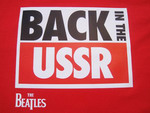 "Back in the USSR" was the first song on the Beatles' 1968 White Album. Written as a parody of an earlier Chuck Berry song, the goal was to humanize the young people living behind the Iron Curtain. In 1988 Paul McCartney put together an official album of Beatles songs directed to his Soviet fans, and issued half a million copies. This was the biggest release by a foreign musician in the Soviet Union and the album sold out rapidly, staying in high demand on the black market. The cover of the album features a quote from McCartney which says: "In releasing this record made especially and exclusively for the USSR, I am extending a hand of peace and friendship to the Soviet people." The Beatles had a major effect in Russia during the time of the Cold War and the release of this album represents a perfect example of how musicians and their songs can influence people in difficult times. Russians were told stories about people in the West, and through the songs of the Beatles they realized that these were not reflecting reality. The Beatles became unintentional cultural ambassadors in times of conflict.
"Back in the USSR" was the first song on the Beatles' 1968 White Album. Written as a parody of an earlier Chuck Berry song, the goal was to humanize the young people living behind the Iron Curtain. In 1988 Paul McCartney put together an official album of Beatles songs directed to his Soviet fans, and issued half a million copies. This was the biggest release by a foreign musician in the Soviet Union and the album sold out rapidly, staying in high demand on the black market. The cover of the album features a quote from McCartney which says: "In releasing this record made especially and exclusively for the USSR, I am extending a hand of peace and friendship to the Soviet people." The Beatles had a major effect in Russia during the time of the Cold War and the release of this album represents a perfect example of how musicians and their songs can influence people in difficult times. Russians were told stories about people in the West, and through the songs of the Beatles they realized that these were not reflecting reality. The Beatles became unintentional cultural ambassadors in times of conflict.
http://www.youtube.com/watch?v=kHD5nd3QLTg -
August 15 - 18, 1969
WOODSTOCK FESTIVAL
Woodstock Festival Epitomized the 1960's Principles of Peace and Love
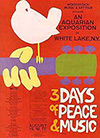 Woodstock Music Festival was billed as '3 days of Peace & Music' and was held in the town of Bethel, New York. Such was the popularity of the sentiment; more than double the expected number of festivalgoers attended and eventually resulted in the event becoming a free festival. A festival of that magnitude had not taken place before but ran peacefully, with festivalgoers contributing to maintaining a sense of social harmony and peace. The legacy of the festival is maintained in popular culture through the famous 'Woodstock' documentary. The Woodstock Festival of 1969 is widely considered the pinnacle of the 1960's zeitgeist advocating freedom of expression and love.
Woodstock Music Festival was billed as '3 days of Peace & Music' and was held in the town of Bethel, New York. Such was the popularity of the sentiment; more than double the expected number of festivalgoers attended and eventually resulted in the event becoming a free festival. A festival of that magnitude had not taken place before but ran peacefully, with festivalgoers contributing to maintaining a sense of social harmony and peace. The legacy of the festival is maintained in popular culture through the famous 'Woodstock' documentary. The Woodstock Festival of 1969 is widely considered the pinnacle of the 1960's zeitgeist advocating freedom of expression and love.
Music is a powerful tool for uniting people through cultural exchange; this is perfectly illustrated by the shared experience of the festivalgoers at Woodstock. The Woodstock Festival remains a symbol of the principles of love and peace embodied by the late 1960's in the hearts and minds of many. -
1971
PING PONG DIPLOMACY
A Thaw in US-China Relations
 'Ping-pong diplomacy' refers to the exchange of table tennis players between the People's Republic of China and the US in the early 1970s. One of the first signs of improved US-China relations was on 6 April 1971, when the American Ping-Pong team was invited by their Chinese colleagues for an all-expense paid visit to the People's Republic of China. Time magazine referred to this event as 'The ping heard around the world'. On 10 April, nine Ping-Pong players and four officials stepped across a bridge from Hong Kong to the Chinese mainland. They were the first group of Americans who were allowed into China after the Communists took over in 1949, thereby starting an era of 'Ping-Pong diplomacy'. Upon return to the US, one of the American players expressed his opinion and said:
'Ping-pong diplomacy' refers to the exchange of table tennis players between the People's Republic of China and the US in the early 1970s. One of the first signs of improved US-China relations was on 6 April 1971, when the American Ping-Pong team was invited by their Chinese colleagues for an all-expense paid visit to the People's Republic of China. Time magazine referred to this event as 'The ping heard around the world'. On 10 April, nine Ping-Pong players and four officials stepped across a bridge from Hong Kong to the Chinese mainland. They were the first group of Americans who were allowed into China after the Communists took over in 1949, thereby starting an era of 'Ping-Pong diplomacy'. Upon return to the US, one of the American players expressed his opinion and said:
'The people are just like us. They are real, they're genuine, and they've got feelings. I made friends, I made genuine friends, you see. The country is similar to America, but still very different. It's beautiful". One of the strongest examples of Cultural Diplomacy, this simple act of bringing together people separated by ideology, distance and culture through the sport of Ping-Pong is considered one of the major precursors to the Chinese-American détente. Improving opinions in both Washington and Beijing, the event signaled intentions of openness by both countries and softened tense relations, paving the way for Nixon's famous Beijing visit in 1972. -
1971
RODRIGUEZ'S 'COLD FACT'
Rodriguez's music during the Anti-apartheid Movement in South Africa
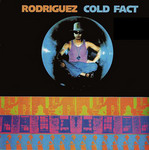 In 1970, American singer/songwriter Sixto Rodriguez released his debut album 'Cold Fact' which failed to achieve notable success in the USA. However unbeknownst to him, the release of 'Cold Fact' in South Africa in 1971 prompted an extremely positive reception, gaining extensive airplay and selling thousands. Many people from South Africa cite Rodriguez's music as incredibly poignant in their struggle against Apartheid. Rodriguez's lyrics which rallied against corrupt governmental systems influenced South African musicians to release their own anti-apartheid songs, uniting the citizens of South Africa in their struggle. It wasn't until 1997 that Rodriguez became aware of his fame abroad, prompting him to go on tour in South Africa, playing six sell-out shows to thousands of fans. 'Cold Fact' became the soundtrack to the people's discontent with the system of racial segregation in South Africa. Rodriguez's music became integral to the struggle for unity and equality, contributing strongly to the cultural identity of South Africa. His music served to mitigate the conflict in South Africa and united the Anti-Apartheid Movement.
In 1970, American singer/songwriter Sixto Rodriguez released his debut album 'Cold Fact' which failed to achieve notable success in the USA. However unbeknownst to him, the release of 'Cold Fact' in South Africa in 1971 prompted an extremely positive reception, gaining extensive airplay and selling thousands. Many people from South Africa cite Rodriguez's music as incredibly poignant in their struggle against Apartheid. Rodriguez's lyrics which rallied against corrupt governmental systems influenced South African musicians to release their own anti-apartheid songs, uniting the citizens of South Africa in their struggle. It wasn't until 1997 that Rodriguez became aware of his fame abroad, prompting him to go on tour in South Africa, playing six sell-out shows to thousands of fans. 'Cold Fact' became the soundtrack to the people's discontent with the system of racial segregation in South Africa. Rodriguez's music became integral to the struggle for unity and equality, contributing strongly to the cultural identity of South Africa. His music served to mitigate the conflict in South Africa and united the Anti-Apartheid Movement. -
July 26, 1973
ENTER THE DRAGON
First-ever US-Hong Kong co-production
 The widespread popularity of Chinese martial art films worldwide in the early 1970's became known as the 'Kung fu wave'. Bruce Lee was the face of this movement and became the first Chinese global superstar. The release of 'Enter the Dragon' in 1973 was the apex of the global 1970's Kung-fu wave and was the first ever US-Hong Kong co-production. The most internationally successful at the time, the USA deemed the film an artifact of 'cultural significance' and has preserved it in the National Film Registry. Historians note the resonance of such films amongst African-Americans, who particularly embraced this genre of film due to the appeal of non-white heroes who often displayed a sense of nationalistic pride. The Hong Kong influence can still be felt in worldwide action cinema today; Quentin Tarantino's recent Kill Bill films are a prime example of this influence, with the films paying homage to the classic martial arts genre.
The widespread popularity of Chinese martial art films worldwide in the early 1970's became known as the 'Kung fu wave'. Bruce Lee was the face of this movement and became the first Chinese global superstar. The release of 'Enter the Dragon' in 1973 was the apex of the global 1970's Kung-fu wave and was the first ever US-Hong Kong co-production. The most internationally successful at the time, the USA deemed the film an artifact of 'cultural significance' and has preserved it in the National Film Registry. Historians note the resonance of such films amongst African-Americans, who particularly embraced this genre of film due to the appeal of non-white heroes who often displayed a sense of nationalistic pride. The Hong Kong influence can still be felt in worldwide action cinema today; Quentin Tarantino's recent Kill Bill films are a prime example of this influence, with the films paying homage to the classic martial arts genre.
Bruce Lee's legacy helped imprint Chinese martial arts culture into the global consciousness. The US-Hong Kong co-production of 'Enter the Dragon' signified a fusion of American and Chinese culture and challenged the dominance of typical western action movies with white heroes. -
1976
ROCK AGAINST RACISM
Superstars sing together to stop extremism
 As a response to racial tensions, prejudice and increasing extremism towards minorities, world-renowned rock starts rallied together in 1976 to kick start the "Rock against Racism" campaign in the United Kingdom. The initiative brought together artists from across all genres, with pop, rock, punk and reggae stars all taking to the stage to present a message of solidarity, tolerance and understanding. The common aim was to create concerts with anti-racist themes and values in order to encourage younger generations to reject racism from their society. The campaign was established in order to give a strong and significant response to a proliferation of racial conflict and to the presence of several nationalist and racist groups such as the National Front and its legacy remains embedded in British society, indeed it paved the way for other musical, cultural events such as LiveAid.
As a response to racial tensions, prejudice and increasing extremism towards minorities, world-renowned rock starts rallied together in 1976 to kick start the "Rock against Racism" campaign in the United Kingdom. The initiative brought together artists from across all genres, with pop, rock, punk and reggae stars all taking to the stage to present a message of solidarity, tolerance and understanding. The common aim was to create concerts with anti-racist themes and values in order to encourage younger generations to reject racism from their society. The campaign was established in order to give a strong and significant response to a proliferation of racial conflict and to the presence of several nationalist and racist groups such as the National Front and its legacy remains embedded in British society, indeed it paved the way for other musical, cultural events such as LiveAid. -
April 24, 1982
'EIN BISSCHEN FRIEDEN' WINS EUROVISION SONG CONTEST
Song promoting world peace wins Eurovision song contest
 Written by German Eurovision-songwriting duo Ralph Siegel and Bernard Meinunger and performed by Nicole, the song 'Ein bisschen Frieden' ('A little bit of peace') won the 1982 Eurovision Song Contest. The lyrics of the song advocated world peace and hope, with Nicole performing the song in German, English, French and Dutch worldwide. The song was later released in Danish, Italian and Russian, with special German-English-Dutch and German-English-Italian combinations being released also. The song gained chart success in many countries and achieved the Eurovision's largest winning margin for the time, reaching a record margin of 61 points.
Written by German Eurovision-songwriting duo Ralph Siegel and Bernard Meinunger and performed by Nicole, the song 'Ein bisschen Frieden' ('A little bit of peace') won the 1982 Eurovision Song Contest. The lyrics of the song advocated world peace and hope, with Nicole performing the song in German, English, French and Dutch worldwide. The song was later released in Danish, Italian and Russian, with special German-English-Dutch and German-English-Italian combinations being released also. The song gained chart success in many countries and achieved the Eurovision's largest winning margin for the time, reaching a record margin of 61 points.
The global success of the song performed at the Eurovision Song Contest, a platform for cultural exchange, highlighted a cross-cultural wish for peace. The performance (and the later release) of the song in various languages made the song's lyrics accessible to people from various countries, promoting unity between cultures.
http://www.youtube.com/watch?v=GvD8Y6gr9lk -
November, 1982
SAMANTHA SMITH - AMERICA'S 'YOUNGEST AMBASSADOR'
Peace Letter from the USA to the Soviet Union
-
1985
'WE ARE THE WORLD'
Benefit Single for African Famine Relief
 The charity single 'We are the World' was recorded by the group 'USA for Africa' to support famine relief efforts in Ethiopia. The idea behind the production of this single came from activist Harry Belafonte and fundraiser Ken Kragen. Michael Jackson and Lionel Richie wrote the lyrics and music and the song was released on 7 March 1985. The song brought together some of the most famous artists in the music industry at the time and was a worldwide success. It topped the music charts throughout the whole world and became the fastest-selling American Pop single in history.The song 'We are the World' reminds us of the fact that we are all human beings living together on this planet and that we should help each other in any way possible. The powerful image of many American musicians joining hands and singing together raised awareness of the famine suffered by the people of Ethiopia.
The charity single 'We are the World' was recorded by the group 'USA for Africa' to support famine relief efforts in Ethiopia. The idea behind the production of this single came from activist Harry Belafonte and fundraiser Ken Kragen. Michael Jackson and Lionel Richie wrote the lyrics and music and the song was released on 7 March 1985. The song brought together some of the most famous artists in the music industry at the time and was a worldwide success. It topped the music charts throughout the whole world and became the fastest-selling American Pop single in history.The song 'We are the World' reminds us of the fact that we are all human beings living together on this planet and that we should help each other in any way possible. The powerful image of many American musicians joining hands and singing together raised awareness of the famine suffered by the people of Ethiopia.
http://www.youtube.com/watch?v=M9BNoNFKCBI -
July 13, 1985
LIVE AID
'Global Jukebox' raises funds for relief of Ethiopian Famine
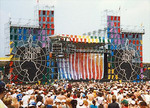 Live Aid was a dual-venue concert organised by Bob Geldof and Midge Ure held on 13 July 1985 to raise relief funds for the famine in Ethiopia. The event was considered a 'global jukebox' as it was held simultaneously at Wembley Stadium in London and the John F. Kennedy Stadium in Pennsylvania. The total number of attendees at the dual event reached over 170,00 people. The dual concert also inspired similar events to be held on the same day in other countries such as Australia and Germany. It was one of the most widely televised events of its time with an estimated global audience of 1.9 billion, across 150 nations. During the concerts, viewers were encouraged to donate money to the Live Aid cause; an estimated £150m is said to have been raised for Ethiopian famine relief as a direct result of the concerts. The success of the Live Aid concerts demonstrate how music can be utilized as a force for good and how it can be used as a source of cultural exchange to bring people together. The magnitude of the global efforts to provide relief for the Ethiopian famine created a sense of unity worldwide.
Live Aid was a dual-venue concert organised by Bob Geldof and Midge Ure held on 13 July 1985 to raise relief funds for the famine in Ethiopia. The event was considered a 'global jukebox' as it was held simultaneously at Wembley Stadium in London and the John F. Kennedy Stadium in Pennsylvania. The total number of attendees at the dual event reached over 170,00 people. The dual concert also inspired similar events to be held on the same day in other countries such as Australia and Germany. It was one of the most widely televised events of its time with an estimated global audience of 1.9 billion, across 150 nations. During the concerts, viewers were encouraged to donate money to the Live Aid cause; an estimated £150m is said to have been raised for Ethiopian famine relief as a direct result of the concerts. The success of the Live Aid concerts demonstrate how music can be utilized as a force for good and how it can be used as a source of cultural exchange to bring people together. The magnitude of the global efforts to provide relief for the Ethiopian famine created a sense of unity worldwide. -
1987
ERASMUS PROGRAM
Broadening horizons and promoting Intercultural Awareness
 The European Union 'Erasmus' student exchange program was founded in 1987 and has been expanding ever since, incorporating an increasing amount of countries and more levels of study. In 2007, the Erasmus program was incorporated into the European Union's ''Lifelong Learning Program 2007-2013''. Since its creation, close to 3 million students have taken part in these exchanges. The program is named after the Dutch philosopher Desiderius Erasmus of Rotterdam who lived and worked in many places in Europe to expand his knowledge and gain new insights. In a similar fashion, the EU program aims to broaden young people's horizons, helping them acquire valuable skills such as the knowledge of foreign languages, adaptability and intercultural awareness.
The European Union 'Erasmus' student exchange program was founded in 1987 and has been expanding ever since, incorporating an increasing amount of countries and more levels of study. In 2007, the Erasmus program was incorporated into the European Union's ''Lifelong Learning Program 2007-2013''. Since its creation, close to 3 million students have taken part in these exchanges. The program is named after the Dutch philosopher Desiderius Erasmus of Rotterdam who lived and worked in many places in Europe to expand his knowledge and gain new insights. In a similar fashion, the EU program aims to broaden young people's horizons, helping them acquire valuable skills such as the knowledge of foreign languages, adaptability and intercultural awareness. -
May 28, 1987
MATHIAS RUST'S 'IMAGINARY BRIDGE'
Pilot Mathias Rust flew from Finland to Moscow to ease Cold War Tensions
 During the Cold War era, 18-year-old Mathias Rust from West Germany flew from Finland to Moscow and illegally landed near the Red Square. Rust's plane was mistaken for a friendly aircraft and was thus able to enter what was deemed the most impenetrable air-defense system in the world. The West's fears of the East were reduced by Mathias' ability to enter Russia unharmed. Mathias' aim was to create an 'imaginary bridge' over the Iron Curtain between the West and the East in order to ease Cold War tensions. Two months after Rust's landing, the leaders of the USA and the Soviet Union signed a treaty to eliminate intermediate-range nuclear weapons in Europe. This daring feat by Mathias Rust acted as a catalyst for the strengthening of relations between the West and the East, helping bring an end to the Cold War era. His message of unity and peace was shared around the world.
During the Cold War era, 18-year-old Mathias Rust from West Germany flew from Finland to Moscow and illegally landed near the Red Square. Rust's plane was mistaken for a friendly aircraft and was thus able to enter what was deemed the most impenetrable air-defense system in the world. The West's fears of the East were reduced by Mathias' ability to enter Russia unharmed. Mathias' aim was to create an 'imaginary bridge' over the Iron Curtain between the West and the East in order to ease Cold War tensions. Two months after Rust's landing, the leaders of the USA and the Soviet Union signed a treaty to eliminate intermediate-range nuclear weapons in Europe. This daring feat by Mathias Rust acted as a catalyst for the strengthening of relations between the West and the East, helping bring an end to the Cold War era. His message of unity and peace was shared around the world. -
1989
THE BALTIC CHAIN
A Human Chain of Two Million People
 On August the 23rd 1989 nearly two million people joined hands to form a human chain, 'The Baltic Chain', which spanned almost 370 miles and 3 countries - the Baltic states of Estonia, Latvia and Lithuania. The Baltic Way marked the 50th anniversary of the Molotov-Ribbentrop Pact between the Soviet Union and Nazi Germany. The pact divided the areas of Eastern Europe into Nazi and Soviet 'spheres of influence' and directly led to the occupation of the Baltic States by the Soviet Union in 1940. The Baltic Way was a call for independence by all three of the Baltic States. The Baltic Way drew much global attention at the time, thereby succeeding in publicizing the Baltic cause and became a symbol of Baltic solidarity. The Baltic Chain was an example of citizen diplomacy that actually succeeded without the use of traditional diplomacy. The effects of the Baltic Way were felt within the year, as Mikhali Gorbachev signed a document condemning the Molotov-Ribbentrop pact, and within 7 months of the protest, Lithuania became the first of the Republics of the Soviet Union to declare independence.
On August the 23rd 1989 nearly two million people joined hands to form a human chain, 'The Baltic Chain', which spanned almost 370 miles and 3 countries - the Baltic states of Estonia, Latvia and Lithuania. The Baltic Way marked the 50th anniversary of the Molotov-Ribbentrop Pact between the Soviet Union and Nazi Germany. The pact divided the areas of Eastern Europe into Nazi and Soviet 'spheres of influence' and directly led to the occupation of the Baltic States by the Soviet Union in 1940. The Baltic Way was a call for independence by all three of the Baltic States. The Baltic Way drew much global attention at the time, thereby succeeding in publicizing the Baltic cause and became a symbol of Baltic solidarity. The Baltic Chain was an example of citizen diplomacy that actually succeeded without the use of traditional diplomacy. The effects of the Baltic Way were felt within the year, as Mikhali Gorbachev signed a document condemning the Molotov-Ribbentrop pact, and within 7 months of the protest, Lithuania became the first of the Republics of the Soviet Union to declare independence. -
1992
VEDRAN SMAILOVIĆ CONCERT DURING BALKAN WAR
Cellist from Sarajevo playing in War Ruins
 Vedran Smailović, a Bosnian cellist, became known to the public after his unusual performances during the Balkan War. In 1992, the Serbian forces launched a 4-year long siege of Sarajevo. Between 1992 and 1993, Smalović played his cello regularly in ruined buildings and during funerals that were often targeted by snipers. His brave acts drew international attention to the dramatic situation in Sarajevo. Smailović became an inspiration for many artists and peacekeepers; and had his story described in the The Cellist of Sarajevo. A simple cello concert played amongst the smoldering ruins of the Balkan capital became one of the most recognizable symbols of peace undertaken by a single man. Once again music had demonstrated its ability to enact real changes in the political world.
Vedran Smailović, a Bosnian cellist, became known to the public after his unusual performances during the Balkan War. In 1992, the Serbian forces launched a 4-year long siege of Sarajevo. Between 1992 and 1993, Smalović played his cello regularly in ruined buildings and during funerals that were often targeted by snipers. His brave acts drew international attention to the dramatic situation in Sarajevo. Smailović became an inspiration for many artists and peacekeepers; and had his story described in the The Cellist of Sarajevo. A simple cello concert played amongst the smoldering ruins of the Balkan capital became one of the most recognizable symbols of peace undertaken by a single man. Once again music had demonstrated its ability to enact real changes in the political world. -
1998
INTERNATIONAL SPACE STATION
International Cooperation in Space
 The construction of the International Space Station (ISS) began on 20 November 1998. The Zarya Module, which was American-funded but built by Russians, was launched into orbit around the earth. An international partnership of space agencies, from the US, Russia, Europe, Japan, Canada came together to assist in the construction of the ISS. The ISS has been the most politically complex space exploration program ever undertaken. At the moment the ISS has a permanent crew of six astronauts, who carry out research in diverse areas such as life, earth and space sciences. The International Space Station was the result of joint efforts by space agencies from sixteen different countries. The project brought together international flights crews, thereby using science as a vehicle for Cultural Diplomacy to strengthen international relations.
The construction of the International Space Station (ISS) began on 20 November 1998. The Zarya Module, which was American-funded but built by Russians, was launched into orbit around the earth. An international partnership of space agencies, from the US, Russia, Europe, Japan, Canada came together to assist in the construction of the ISS. The ISS has been the most politically complex space exploration program ever undertaken. At the moment the ISS has a permanent crew of six astronauts, who carry out research in diverse areas such as life, earth and space sciences. The International Space Station was the result of joint efforts by space agencies from sixteen different countries. The project brought together international flights crews, thereby using science as a vehicle for Cultural Diplomacy to strengthen international relations. -
1999
MUSICANS WITHOUT BORDERS
Using the Power of Music
 'Musicians without Borders' is a global organization founded in 1999. The goal of the organization is to use music as an instrument in order to heal and reconcile specific areas of conflict and war. The organization develops musical projects which seek to alleviate suffering of the afflicted peoples and works in cooperation with local musicians and civil society organizations. Musicians without Borders has been active in several conferences and music festivals and has led to the creation a whole network of musicians and organizations from across the world. The organization 'Musicians without Borders' aims to connect cultures and use music as a vehicle in order to heal the wounds of victims of war and conflicts. Community music-making is an accessible way to connect people and give them a way to deal with trauma.
'Musicians without Borders' is a global organization founded in 1999. The goal of the organization is to use music as an instrument in order to heal and reconcile specific areas of conflict and war. The organization develops musical projects which seek to alleviate suffering of the afflicted peoples and works in cooperation with local musicians and civil society organizations. Musicians without Borders has been active in several conferences and music festivals and has led to the creation a whole network of musicians and organizations from across the world. The organization 'Musicians without Borders' aims to connect cultures and use music as a vehicle in order to heal the wounds of victims of war and conflicts. Community music-making is an accessible way to connect people and give them a way to deal with trauma. -
2000s
CULINARY DIPLOMACY
Cooking up a better world
 Culinary Diplomacy, sometimes also called ''Gastrodiplomacy'', is defined as the use of food as an instrument to create cross-cultural understanding in the hopes of improving interactions and cooperation. Culinary Diplomacy is a relatively recent innovation in the field of Culture Diplomacy, making its official introduction at the beginning of this century with several governments such as South Korea and Thailand sponsoring culinary initiatives. It was mentioned in a 2002 Economist article on ''The Thai Kitchen of the World'' program, the world's first government-led culinary diplomacy initiative that really coined the term and inspired other governments to follow suit. In 2012 the US government took note and launched its very own ''Culinary Diplomacy Partnership Initiative'' with more than 80 American Chefs being named to its ''American Chef Corps'' and being sent abroad on a public diplomacy mission to educate foreign audiences on American cuisine'.
Culinary Diplomacy, sometimes also called ''Gastrodiplomacy'', is defined as the use of food as an instrument to create cross-cultural understanding in the hopes of improving interactions and cooperation. Culinary Diplomacy is a relatively recent innovation in the field of Culture Diplomacy, making its official introduction at the beginning of this century with several governments such as South Korea and Thailand sponsoring culinary initiatives. It was mentioned in a 2002 Economist article on ''The Thai Kitchen of the World'' program, the world's first government-led culinary diplomacy initiative that really coined the term and inspired other governments to follow suit. In 2012 the US government took note and launched its very own ''Culinary Diplomacy Partnership Initiative'' with more than 80 American Chefs being named to its ''American Chef Corps'' and being sent abroad on a public diplomacy mission to educate foreign audiences on American cuisine'. -
2000
MUSIC 4 PEACE
Music Foundation set up to spread Peace
 The Music 4 Peace Foundation was set up in 2000 by Tobias Huber with the aim to spread peace through cultural exchange. Music and art are used as a means to achieve social unity and to promote non-violence. The Foundation's projects are predominantly targeted at the youth, as they will be the ones who will be shaping the future of the planet. The Foundation runs and supports educational programs, cultural projects and music events as well as working with a numerous partner organisations that all share the mission of peace. Music 4 Peace has supported a wide-range of cultural music events such as the United Nation's 'No Excuse Concert' and Asia's largest World Performing Arts Festival in Pakistan. By working with and supporting fellow peace organisations, Music 4 Peace can spread their message of peace and non-violence. The shared experience integral to music and art can unify people from a plethora of cultures.
The Music 4 Peace Foundation was set up in 2000 by Tobias Huber with the aim to spread peace through cultural exchange. Music and art are used as a means to achieve social unity and to promote non-violence. The Foundation's projects are predominantly targeted at the youth, as they will be the ones who will be shaping the future of the planet. The Foundation runs and supports educational programs, cultural projects and music events as well as working with a numerous partner organisations that all share the mission of peace. Music 4 Peace has supported a wide-range of cultural music events such as the United Nation's 'No Excuse Concert' and Asia's largest World Performing Arts Festival in Pakistan. By working with and supporting fellow peace organisations, Music 4 Peace can spread their message of peace and non-violence. The shared experience integral to music and art can unify people from a plethora of cultures. -
2001
THE SHARED VALUE INITIATIVE
Changing the idea of Muslim Americans after the 9/11
 In 2001, immediately after 9/11, the Shared Values Initiative was launched by the U.S. State Department under the supervision of Charlotte Beers, a former Madison Avenue advertising executive. The initiative consisted of five mini-documentaries, a promotional website and other numerous communication elements, including TV spots and radio programs. The videos portrayed "Real Muslim Americans" participating in their daily activities. The Shared Value Initiative was designed with the attempt of persuading the audience of Muslim countries to be more aware of American culture by eliminating myths about the treatment of Muslims in the US. As a result, the initiative intended to promote a "new" America to Muslims, by showing that American Muslims were living happily and free to participate in their daily activity in America without persecution.
In 2001, immediately after 9/11, the Shared Values Initiative was launched by the U.S. State Department under the supervision of Charlotte Beers, a former Madison Avenue advertising executive. The initiative consisted of five mini-documentaries, a promotional website and other numerous communication elements, including TV spots and radio programs. The videos portrayed "Real Muslim Americans" participating in their daily activities. The Shared Value Initiative was designed with the attempt of persuading the audience of Muslim countries to be more aware of American culture by eliminating myths about the treatment of Muslims in the US. As a result, the initiative intended to promote a "new" America to Muslims, by showing that American Muslims were living happily and free to participate in their daily activity in America without persecution. -
2001
THE JEAN BELIVEAU PEACE WALK AROUND THE WORLD
11-Year Walk for Peace
 In 2000, the small company of the Canadian man Jean Beliveau went bankrupt. To avoid exasperation, he decided to travel around the world by foot, carrying only with him the bare necessities. He was welcomed into stranger's homes; he was fed and supported from people around the world for the duration of his 11 years walk. The real mission of the action, he said, was to encourage Canada and other governments to create "ministries of peace". He also expressed his view of the world by claiming: "we are all different, and that is what is beautiful about life on Earth - our different colours, different beliefs, different political systems". Walking across the world abated his previously held stereotypes regarding people from other cultures and thus helped him gain a wider perspective of the world. He was touched by the compassion of the people who opened their homes to him despite being a total stranger and the support he encountered for his actions and goals. This peaceful act and way of experiencing the world can hopefully inspire more people to fight their prejudices and encourage them to appreciate the plethora of cultures across the world. The story of Beliveau demonstrates the possibility of a simple act to spread the principles of peace around the globe and to influence national politics.
In 2000, the small company of the Canadian man Jean Beliveau went bankrupt. To avoid exasperation, he decided to travel around the world by foot, carrying only with him the bare necessities. He was welcomed into stranger's homes; he was fed and supported from people around the world for the duration of his 11 years walk. The real mission of the action, he said, was to encourage Canada and other governments to create "ministries of peace". He also expressed his view of the world by claiming: "we are all different, and that is what is beautiful about life on Earth - our different colours, different beliefs, different political systems". Walking across the world abated his previously held stereotypes regarding people from other cultures and thus helped him gain a wider perspective of the world. He was touched by the compassion of the people who opened their homes to him despite being a total stranger and the support he encountered for his actions and goals. This peaceful act and way of experiencing the world can hopefully inspire more people to fight their prejudices and encourage them to appreciate the plethora of cultures across the world. The story of Beliveau demonstrates the possibility of a simple act to spread the principles of peace around the globe and to influence national politics. -
2003
THE WOMEN OF LIBERIA MASS ACTION FOR PEACE
Grassroots Engagement for Peace
 In 2003, the bottom-up project started by the Women in Peace building Network issued a statement of intent stating that "in the past we were silent, but after being killed, raped, dehumanized, and infected with diseases, and watching our children and families destroyed, war has taught us that the future lies in saying NO to violence and YES to peace! We will not relent until peace prevails". The organisation initiated a peaceful act in which thousands of Liberian women of different religions, ethnic identities, ages and social backgrounds sang, danced and prayed for peace every day for months in a fish market. The act forced President Charles Taylor to take part in peace negotiations in Ghana. During the talks between the President and the rebel groups, a delegation of Liberian women went to Ghana to continue their struggle for peace. They continued to apply pressure on the negotiators until a peace agreement was reached. This peaceful and successful action has been noticed and awarded all over the world, not least by the Nobel Peace Prize of 2011. Not only did their actions help Liberia to reach peace, but it also lessened tensions and fostered increased tolerance between the different groups of the society.
In 2003, the bottom-up project started by the Women in Peace building Network issued a statement of intent stating that "in the past we were silent, but after being killed, raped, dehumanized, and infected with diseases, and watching our children and families destroyed, war has taught us that the future lies in saying NO to violence and YES to peace! We will not relent until peace prevails". The organisation initiated a peaceful act in which thousands of Liberian women of different religions, ethnic identities, ages and social backgrounds sang, danced and prayed for peace every day for months in a fish market. The act forced President Charles Taylor to take part in peace negotiations in Ghana. During the talks between the President and the rebel groups, a delegation of Liberian women went to Ghana to continue their struggle for peace. They continued to apply pressure on the negotiators until a peace agreement was reached. This peaceful and successful action has been noticed and awarded all over the world, not least by the Nobel Peace Prize of 2011. Not only did their actions help Liberia to reach peace, but it also lessened tensions and fostered increased tolerance between the different groups of the society. -
2004
CONFUCIUS INSTITUTE
The Chinese instrument of Soft Power
 The first Confucius Institute was created on the 21st of November 2004 in Seoul, South Korea. Following this, hundreds more have been opened in dozens of countries around the world. Confucius Institutes headquarters are located in Beijing, since the program is controlled and overseen by the Office of Chinese Language Council International, a non-profit organization that collaborates with the Chinese Government. The number of Confucius Institutes around the globe has multiple functions linked to the strategy of "soft power" employed by the Chinese government, such as the promotion and teaching of Chinese language and culture abroad as well as the encouraging of trade relations abroad. Here, Cultural Diplomacy is actively being used by China to promote a favourable image of the economic giant abroad.
The first Confucius Institute was created on the 21st of November 2004 in Seoul, South Korea. Following this, hundreds more have been opened in dozens of countries around the world. Confucius Institutes headquarters are located in Beijing, since the program is controlled and overseen by the Office of Chinese Language Council International, a non-profit organization that collaborates with the Chinese Government. The number of Confucius Institutes around the globe has multiple functions linked to the strategy of "soft power" employed by the Chinese government, such as the promotion and teaching of Chinese language and culture abroad as well as the encouraging of trade relations abroad. Here, Cultural Diplomacy is actively being used by China to promote a favourable image of the economic giant abroad. -
2004
PLAYING FOR CHANGE
Bringing People Together Through Music
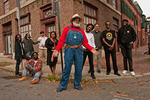 'Playing for Change' is a global multimedia music project, started in 2004, which attempts to bring together musicians from all over the world. The project, initiated by the American producer and sound engineer Mark Johnson also created the non-profit organization "Playing for Change Foundation", which builds music schools for children around the world. The project uses the medium of music to achieve its main aims: to inspire, connect and bring peace to the world. Mark Johnson travelled around the world to record the same song performed by a number of different musicians, each with their own interpretation of the song. The first song recorded was "Stand by me", and all the recordings have recently been made into a short film, which has reached over 56 Million views on YouTube. Music is an exemplary tool to achieve peace and to connect people from different countries and cultures, focusing on unity instead of difference. 'Playing for Change' crosses national boundaries in as similar way to the Eurovision Song Contest.
'Playing for Change' is a global multimedia music project, started in 2004, which attempts to bring together musicians from all over the world. The project, initiated by the American producer and sound engineer Mark Johnson also created the non-profit organization "Playing for Change Foundation", which builds music schools for children around the world. The project uses the medium of music to achieve its main aims: to inspire, connect and bring peace to the world. Mark Johnson travelled around the world to record the same song performed by a number of different musicians, each with their own interpretation of the song. The first song recorded was "Stand by me", and all the recordings have recently been made into a short film, which has reached over 56 Million views on YouTube. Music is an exemplary tool to achieve peace and to connect people from different countries and cultures, focusing on unity instead of difference. 'Playing for Change' crosses national boundaries in as similar way to the Eurovision Song Contest.
http://www.youtube.com/watch?v=Us-TVg40ExM -
2005
THE RHYTHM ROAD: AMERICAN MUSIC ABROAD
US Jazz Diplomacy in the Post-Cold War Era
 Following in the footsteps of Cold War "Jazz Ambassadors" like Dizzy Gillespie and Louis Armstrong, the US State Department launched the "Rhythm Road" program which involved sending American musicians abroad to areas where the US society and culture are often met with animosity. Rhythm Road represents the new generation of musical ambassadors; reaching beyond concert halls to interact with other musicians and citizens around the globe. Designed to promote intercultural dialogue, bypass negative images and fight stereotypes, the program has seen American artists interact with peoples and audiences from Africa, Asia and South America.
Following in the footsteps of Cold War "Jazz Ambassadors" like Dizzy Gillespie and Louis Armstrong, the US State Department launched the "Rhythm Road" program which involved sending American musicians abroad to areas where the US society and culture are often met with animosity. Rhythm Road represents the new generation of musical ambassadors; reaching beyond concert halls to interact with other musicians and citizens around the globe. Designed to promote intercultural dialogue, bypass negative images and fight stereotypes, the program has seen American artists interact with peoples and audiences from Africa, Asia and South America.
Although an overt act of Cultural Diplomacy sponsored at the state level, Rhythm Road promotes real grassroots interaction between US musicians and peoples of the world, promoting a spirit of cooperation, friendship, creativity and peace. -
2005
I ♥ Hip Hop
First Hip-Hop Festival in Morocco
 Whilst in Marrakesh as a Fulbright scholar in 2004, filmmaker Josh Asen was surprised to discover the sounds Eminem, 50 Cent, and other hip-hop mixed in with the traditional notes of tribal music. Asen had stumbled across 'fnaire', a local group specialising in laying complex beats over samples of traditional Arabic music, transcending cultural barriers with their tracks. Captivated by what he was witnessing, Asen abandoned his studies and immersed himself in this new music scene populated by 'fnaire' and other young North Africans. Talking to the local rap artists, Asen realised that their style of music faced fundamental misunderstanding and resistance. Powerful conservative elements in the country suppressed the musical movement, conflating any sign of hip hop with an aggressive, immoral and anti-Islam agenda. However, far from rapping about violence, guns, and cars, the young artists were conveying a positive message and using their hip hop as vehicle for change. As Asen explained of the message, "Hip-hop is part of the democratic process. It is the empowerment and the birth of the voice of the oppressed, of the underclass, this is the young people seizing a voice for themselves, in a way they haven't done since the seventies". With the help of Asen and the US Embassy, the young North African musicians secured funding for a major hip hop festival, drawing crowds of thousands and gaining international attention. Truly an act of international Cultural Diplomacy, the "I ♥ hip hop" festival project was the culmination of efforts from different counties and cultures working together to express themselves and provide a new voice to the peoples of North Africa. The cultural exchange not only provided a voice for the young generations of North Africa but also presented to the world a more modern and progressive vision of North Africa to the world, a vision free from demonized stereotypes of Islamic countries and the Arabic world.
Whilst in Marrakesh as a Fulbright scholar in 2004, filmmaker Josh Asen was surprised to discover the sounds Eminem, 50 Cent, and other hip-hop mixed in with the traditional notes of tribal music. Asen had stumbled across 'fnaire', a local group specialising in laying complex beats over samples of traditional Arabic music, transcending cultural barriers with their tracks. Captivated by what he was witnessing, Asen abandoned his studies and immersed himself in this new music scene populated by 'fnaire' and other young North Africans. Talking to the local rap artists, Asen realised that their style of music faced fundamental misunderstanding and resistance. Powerful conservative elements in the country suppressed the musical movement, conflating any sign of hip hop with an aggressive, immoral and anti-Islam agenda. However, far from rapping about violence, guns, and cars, the young artists were conveying a positive message and using their hip hop as vehicle for change. As Asen explained of the message, "Hip-hop is part of the democratic process. It is the empowerment and the birth of the voice of the oppressed, of the underclass, this is the young people seizing a voice for themselves, in a way they haven't done since the seventies". With the help of Asen and the US Embassy, the young North African musicians secured funding for a major hip hop festival, drawing crowds of thousands and gaining international attention. Truly an act of international Cultural Diplomacy, the "I ♥ hip hop" festival project was the culmination of efforts from different counties and cultures working together to express themselves and provide a new voice to the peoples of North Africa. The cultural exchange not only provided a voice for the young generations of North Africa but also presented to the world a more modern and progressive vision of North Africa to the world, a vision free from demonized stereotypes of Islamic countries and the Arabic world. -
2006
DANCING TO CONNECT
Connecting the world through dance
 The ''Dancing to Connect'' initiative was founded in 2006 by Battery Dance Company, a New York City Dance community, and was sponsored by the US Department of State and the US Bureau of Educational and Cultural Affairs. The key goal of the initiative is to bring youths together from both sides of a ' pressing conflict' and bring them together in a series of workshops, helping to engage them in teambuilding and creativity through dance. The initiative is currently operational in 26 countries across the world and aims to expand this number to fifty by 2017. One of its highlights so far has been the Israeli-Palestinian-German Dancing to Connect 2011, bridging the Israeli-Palestinian divide. Widely regarded as a success, the initiative is a good example of ''New school' Cultural Diplomacy, conducted by private organisations and civil society rather than by governments.
The ''Dancing to Connect'' initiative was founded in 2006 by Battery Dance Company, a New York City Dance community, and was sponsored by the US Department of State and the US Bureau of Educational and Cultural Affairs. The key goal of the initiative is to bring youths together from both sides of a ' pressing conflict' and bring them together in a series of workshops, helping to engage them in teambuilding and creativity through dance. The initiative is currently operational in 26 countries across the world and aims to expand this number to fifty by 2017. One of its highlights so far has been the Israeli-Palestinian-German Dancing to Connect 2011, bridging the Israeli-Palestinian divide. Widely regarded as a success, the initiative is a good example of ''New school' Cultural Diplomacy, conducted by private organisations and civil society rather than by governments. -
2007
BEATING WING ORCHESTRA
Music Collective of Refugee and Migrant Members
 The Beating Wing Orchestra was born from a project set up by Community Arts North West. The Orchestra is based in Manchester and is an international musical collective consisting of members from refugee or migrant backgrounds. Each of the musicians brought to the collective their own culturally influenced music styles. The orchestra's rich multinational sound has attracted much praise within its community and beyond as highlighted by their repeated participation in the Manchester International Festival. The Beating Wing Orchestra has also attracted the attention of esteemed composers and contemporary international artists leading to a number of successful collaborations. The formation of the Beating Wing Orchestra is a prime example of Cultural Diplomacy within the community as it strengthens relations between Manchester's rich mix of nationalities and cultures. The cultural exchange shared within the orchestra increases awareness and appreciation of a wealth of different cultures.
The Beating Wing Orchestra was born from a project set up by Community Arts North West. The Orchestra is based in Manchester and is an international musical collective consisting of members from refugee or migrant backgrounds. Each of the musicians brought to the collective their own culturally influenced music styles. The orchestra's rich multinational sound has attracted much praise within its community and beyond as highlighted by their repeated participation in the Manchester International Festival. The Beating Wing Orchestra has also attracted the attention of esteemed composers and contemporary international artists leading to a number of successful collaborations. The formation of the Beating Wing Orchestra is a prime example of Cultural Diplomacy within the community as it strengthens relations between Manchester's rich mix of nationalities and cultures. The cultural exchange shared within the orchestra increases awareness and appreciation of a wealth of different cultures. -
2008-2010
WOMEN ARE HEROES
A Tribute to Women Worldwide
 In 2008, the French urban 'Artivist' JR initiated the 'Women Are Heroes' project, in which he highlights the dignity of women who are often targets during conflicts. In his international tour for 'Women are Heroes' he went to Cambodia, India, Brazil, Kenya, Liberia and Sierra Leone and pasted enormous posters of captured images in public spaces - on walls of churches and mosques, the sides of buses and trains etc. The project introduces us to women have looked death in the face and have had a painful past, but dream of a bright future. Looking inside the minds of these women, JR tried to get close to what is common to all of them: namely the human being. Through the 'Women are Heroes' project, JR tried to describe tales of women who experienced horror and hardships in their life, through art. His project is one of images over words. Women from all over the world are brought together to share both the nightmares of their past and their hopes for their future, in front of JR's camera.
In 2008, the French urban 'Artivist' JR initiated the 'Women Are Heroes' project, in which he highlights the dignity of women who are often targets during conflicts. In his international tour for 'Women are Heroes' he went to Cambodia, India, Brazil, Kenya, Liberia and Sierra Leone and pasted enormous posters of captured images in public spaces - on walls of churches and mosques, the sides of buses and trains etc. The project introduces us to women have looked death in the face and have had a painful past, but dream of a bright future. Looking inside the minds of these women, JR tried to get close to what is common to all of them: namely the human being. Through the 'Women are Heroes' project, JR tried to describe tales of women who experienced horror and hardships in their life, through art. His project is one of images over words. Women from all over the world are brought together to share both the nightmares of their past and their hopes for their future, in front of JR's camera. -
2011
UNHATE CAMPAIGN UNITED COLOR OF BENETTON
Benetton created its New Worldwide Communication Campaign against Hate
 In 2011, the Benetton group created the UNHATE Foundation for its new worldwide communication campaign. The campaign was an invitation to the leaders and citizens of the world to combat the culture of hatred in all its forms. According to Benetton "These are symbolic images of reconciliation—with a touch of ironic hope and constructive provocation—to stimulate reflection on how politics, faith and ideas, even when they are divergent and mutually opposed, must still lead to dialogue and mediation". The new campaign, the creation of the Foundation and the other initiatives of the UNHATE project reflected Benetton's wish to drive the desire for participation and change that animates the world's citizens. The controversial ad series won the Press Grand Prix at the Cannes Ad Festival in 2012 and represents an oustanding example of Cultural Diplomacy as it aims at contributing to the creation of a new culture against hate in the international community.
In 2011, the Benetton group created the UNHATE Foundation for its new worldwide communication campaign. The campaign was an invitation to the leaders and citizens of the world to combat the culture of hatred in all its forms. According to Benetton "These are symbolic images of reconciliation—with a touch of ironic hope and constructive provocation—to stimulate reflection on how politics, faith and ideas, even when they are divergent and mutually opposed, must still lead to dialogue and mediation". The new campaign, the creation of the Foundation and the other initiatives of the UNHATE project reflected Benetton's wish to drive the desire for participation and change that animates the world's citizens. The controversial ad series won the Press Grand Prix at the Cannes Ad Festival in 2012 and represents an oustanding example of Cultural Diplomacy as it aims at contributing to the creation of a new culture against hate in the international community. -
2012
BEFORE THEY PASS AWAY
Preserving Cultural Heritage in an Era of Globalization
 The photographer Jimmy Nelson travelled for three-and-a-half years around the world to document the vanishing cultures of the world. Nelson photographed 35 populations with no intention to adapt to the modern world and spent up to two weeks with each population in order to capture the 'true image' of their culture. Nelson was familiarized with traditional rituals and customs, documenting these through photography. His photographs show unique hairstyles, jewellery, and clothing in front of astonishing surroundings. Nelson's idea was to show the 'purity of humanity' and to capture diminishing cultures before they pass away. He wanted: "to create an ambitious aesthetic photographic document that would stand the test of time. A body of work that would be an irreplaceable ethnographic record of a fast disappearing world." 'Before they pass away' is a perfect example of Cultural Diplomacy in practice through the medium of art. The photographs show the necessity of preserving cultural heritage in a time of globalization. Its focus on showing different ways of life and making people aware of existing cultures around the world is of paramount importance.
The photographer Jimmy Nelson travelled for three-and-a-half years around the world to document the vanishing cultures of the world. Nelson photographed 35 populations with no intention to adapt to the modern world and spent up to two weeks with each population in order to capture the 'true image' of their culture. Nelson was familiarized with traditional rituals and customs, documenting these through photography. His photographs show unique hairstyles, jewellery, and clothing in front of astonishing surroundings. Nelson's idea was to show the 'purity of humanity' and to capture diminishing cultures before they pass away. He wanted: "to create an ambitious aesthetic photographic document that would stand the test of time. A body of work that would be an irreplaceable ethnographic record of a fast disappearing world." 'Before they pass away' is a perfect example of Cultural Diplomacy in practice through the medium of art. The photographs show the necessity of preserving cultural heritage in a time of globalization. Its focus on showing different ways of life and making people aware of existing cultures around the world is of paramount importance. -
2012
ISRAEL LOVES IRAN
An Online Call for Peace initiated by an Israeli Couple
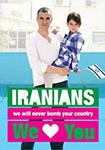
'Israel loves Iran' is a social media movement whose goal it is to promote peace between the two countries and to bring Israelis and Iranians together. It was initiated by the Israeli, Ronny Edran, who posted a picture of himself and his young daughter on Facebook with a graphic stating, "Iranians, we love you, we will never bomb your country". The photo went viral and achieved the support of 1000 Israelis and Iranians. The campaign is a good example of Cultural Diplomacy in practice, as the main purpose of the movement was to bring the Israelis and Iranians together and to improve the relations between the two countries using social media. -
2012
VIRTUAL DINNER GUEST PROJECT
Virtual Dinners: Breaking Bread, Breaking Barriers
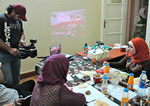 The Virtual Dinner Guest Project is an international forum of dialogue that is based on the premise: 'It is harder to ignore, vilify or harm those with whom we have broken bread'. The mission of the project is to connect the world at its dinner tables in order to promote free speech, alternative media, and social innovation. During a 90-minute dinner shared via Skype, participants discuss news headlines of their communities on topics like human rights, development and public health. When the dinner ends, the creative parts begin as both parties take a few questions to the streets of their local communities, and film people's responses. This project bridges geographic distances, connecting people across their cultural differences over a virtual dinner. Discussing relevant news topics with people from across the globe (e.g. native Americans who dine with inhabitants of the Gaza Strip) is an ideal way of exchanging cultures and improving relations between divergent groups.
The Virtual Dinner Guest Project is an international forum of dialogue that is based on the premise: 'It is harder to ignore, vilify or harm those with whom we have broken bread'. The mission of the project is to connect the world at its dinner tables in order to promote free speech, alternative media, and social innovation. During a 90-minute dinner shared via Skype, participants discuss news headlines of their communities on topics like human rights, development and public health. When the dinner ends, the creative parts begin as both parties take a few questions to the streets of their local communities, and film people's responses. This project bridges geographic distances, connecting people across their cultural differences over a virtual dinner. Discussing relevant news topics with people from across the globe (e.g. native Americans who dine with inhabitants of the Gaza Strip) is an ideal way of exchanging cultures and improving relations between divergent groups. -
August 19, 2013
HIJABUPPROPET (THE HIJAB APPEAL)
Social Media Solidarity with Veiled Women
 On August 16th, a heavily pregnant Muslim woman was attacked in Sweden for wearing a veil. Following the attack, the hijab appeal was launched on Twitter, encouraging women of all faiths to wear a veil on the 19th August as a sign of solidarity to the assaulted woman. The appeal garnered immense media attention as thousands of women took to social media to post photos of themselves wearing a veil with the hashtag "#hijabuppropet", including television presenters and MPs. Some of the women who were behind the appeal were invited to discuss the issue of hate crimes with the Minister for Justice Beatrice Ask; the women advocated for a Government commission to regulate the manner in which police handle hate crimes against Muslims. The Hijab appeal raised awareness of the need to tackle intolerance toward Muslims. The unified action of thousands of social media users demonstrated respect for the beliefs and choices of others.
On August 16th, a heavily pregnant Muslim woman was attacked in Sweden for wearing a veil. Following the attack, the hijab appeal was launched on Twitter, encouraging women of all faiths to wear a veil on the 19th August as a sign of solidarity to the assaulted woman. The appeal garnered immense media attention as thousands of women took to social media to post photos of themselves wearing a veil with the hashtag "#hijabuppropet", including television presenters and MPs. Some of the women who were behind the appeal were invited to discuss the issue of hate crimes with the Minister for Justice Beatrice Ask; the women advocated for a Government commission to regulate the manner in which police handle hate crimes against Muslims. The Hijab appeal raised awareness of the need to tackle intolerance toward Muslims. The unified action of thousands of social media users demonstrated respect for the beliefs and choices of others. -
2013
BASKETBALL DIPLOMACY
Dennis Rodman's brings his Basketball to North Korea
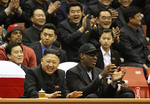 In September 2013 Dennis Rodman, retired American Hall of Fame professional basketball player, announced that he had accepted the position of head coach with North Korea's national basketball team. Although initially rather controversial, Rodman's trip has increasingly been interpreted as a meaningful act of bilateral, non-governmental cooperation that has indirectly thawed relations between the USA and the North Korea. Very few Americans have the opportunity to visit North Korea and no single North Korean leader has been granted a visit to the USA. As such, Rodman's move was quite exceptional; especially considering that it came barely a year after Pyongyang threated the Western World with a nuclear attack. The cooperation between the 'bad boy' pierced, tattooed and cursing American sport celebrity and Kim Jong-un is a fantastic example of Cultural Diplomacy through sport. It continues the tradition of unusual yet effective intercultural dialogue first seen with the Ping-Pong diplomacy of 1940s. A less politicized approach, which does not deliver direct political prestige or diplomatic recognition, can have a positive influence on official relations between countries.
In September 2013 Dennis Rodman, retired American Hall of Fame professional basketball player, announced that he had accepted the position of head coach with North Korea's national basketball team. Although initially rather controversial, Rodman's trip has increasingly been interpreted as a meaningful act of bilateral, non-governmental cooperation that has indirectly thawed relations between the USA and the North Korea. Very few Americans have the opportunity to visit North Korea and no single North Korean leader has been granted a visit to the USA. As such, Rodman's move was quite exceptional; especially considering that it came barely a year after Pyongyang threated the Western World with a nuclear attack. The cooperation between the 'bad boy' pierced, tattooed and cursing American sport celebrity and Kim Jong-un is a fantastic example of Cultural Diplomacy through sport. It continues the tradition of unusual yet effective intercultural dialogue first seen with the Ping-Pong diplomacy of 1940s. A less politicized approach, which does not deliver direct political prestige or diplomatic recognition, can have a positive influence on official relations between countries.

